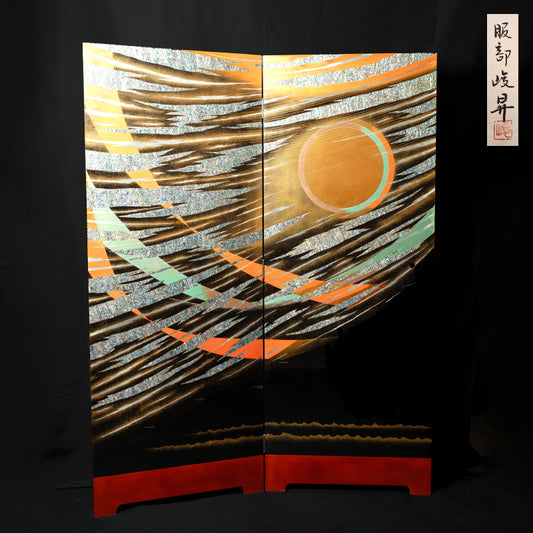Hattori Shunshō (Toshio, 1943-2018) was born the third son of fabric business owner Hattori Shōtarō and his wife Uno on January 6, 1943 in Kyoto`s Shimogyō ward. Encouraged by his middle school art teacher, in 1958, he enrolled in the lacquer arts program at Kyoto Municipal Hiyoshigaoka High School (later known as DODA and now the Kyoto Municipal High School of Arts and Crafts). There, he studied under lacquer artists Mizunai Kyōhei and Hiraishi Akihiro. His graduation work in 1961, a lacquer panel titled Kajin (Beautiful Woman), received the Education Committee Award. That same year, he joined Nakamura Design Studio in Kyoto while continuing his artistic pursuits until 1965. In 1962, his lacquer panel Onna (Woman) was selected for the 14th Kyoten Exhibition, marking his first public acceptance. In 1963, his lacquer panel Night Performer was selected for the 6th Shin-Nitten Exhibition. In 1964, he debuted at the 17th Kyoto Craft Art Exhibition and became a regular exhibitor. That same year, he joined Shugen-kai, a contemporary lacquer art research group, and exhibited his lacquer panel Flight, continuing to participate annually. He studied lacquer art under Banura Shōgo, the leader of Shugen-kai. In 1965, he apprenticed under Uehara Kiyoshi to study maki-e (gold and silver lacquer techniques).
In 1969, he won the Excellence Award at the 22nd Kyoto Craft Art Exhibition, and in 1970, his two-panel folding screen Floral Elephant received the Mayor’s Prize at the 22nd Kyoten Exhibition. That same year, he co-founded Forme, a group of young Kyoto-based lacquer artists, alongside Itō Yūji and Suzuki Masaya (the third-generation Suzuki Hyōsaku). Influenced by the avant-garde art movement of the 1960s and 70s, Forme actively incorporated new materials such as acrylic and cashew lacquer into lacquer art and experimenting with substrata , a freedom made possible by technological innovations during the post-war era. Which also lead to a plethora of more easily manufactured and applied inlays. In addition, the world became a bit smaller during this time, allowing artists to acquire materials from such far-off places a Mexico and New Zealand. Until its dissolution in 1978, the group pursued experimental approaches that fused traditional lacquer techniques with modern materials.
In 1972, he received the Special Selection Award at the 4th Nitten Exhibition for his two-panel folding screen Core of the Sun. In 1975, as a recipient of the Agency for Cultural Affairs’ overseas training program, he studied etching in Europe and the United States for a year, training at the Konstakademien in Sweden and the printmaking studio of S.W. Hayter in France.
=
Hattori Shunsho EXHIBITION "Geometry" Digital Catalog
Pieces by Hattori Shunsho | 服部 峻昇 "Geometry"
-
2 Panel Lacquer Screen ー服部 峻昇 “耀貝二曲屏風 朝陽の響”
Regular price ¥2,616,700 JPYRegular priceUnit price / per -
Contemporary Lacquer Mizusashi ー服部 峻昇 “水差 月の海”
Regular price ¥581,500 JPYRegular priceUnit price / per -
Rippling Lacquer Box ー服部 峻昇 “白耀貝飾箱 流文”
Regular price ¥1,163,000 JPYRegular priceUnit price / per -
Nishiki Pattern Lacquer Box ー服部 峻昇 “耀貝飾箱 彩華”
Regular price ¥1,133,900 JPYRegular priceUnit price / per




